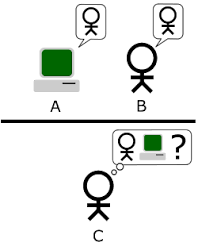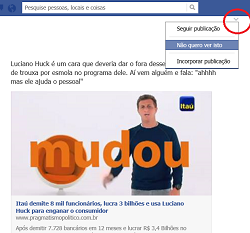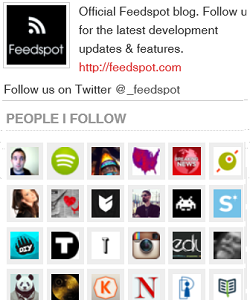
Arquivo para a ‘Mineração de dados’ Categoria
Research develops new Turing test
 Alan Turing a pioneer of Computing, which developed a theoretical model called after Turing machine, completed after mathematician Alonzo Church in 1938, which gave rise to all computing algorithms, the basic principle stated:
Alan Turing a pioneer of Computing, which developed a theoretical model called after Turing machine, completed after mathematician Alonzo Church in 1938, which gave rise to all computing algorithms, the basic principle stated:
“The algorithm consists of a finite set of simple and precise instructions that are described by a finite number of symbols.”
About this idea was proposed a test, called the Turing Test, that if something was proposed to a person and a machine and we could not decide which was the response of a machine, would have been an “intelligence” machine.
Now a professor at Georgia Tech, Mark Riedi claimed to have developed an algorithm that describe it as a more accurate way to evaluate the potential of a smart machine than the famous Turing test, as the news in Georgia Tech site.
The new Riedi test, called Artificial Intelligence Creativity Test and the Lovelace 2.0 are based on Lovelace test, created in 2001, testing the production of a work of art or other creative enough human labor.
Ried believes that the original test was very subjective and created specific parameters for your test to be followed by a human reviewer. This allows the evaluator to assess the creative work of a machine without making subjective judgments of value.
Riedi will be presenting its new test with the Beyond the Turing Test, in Workshop of the Association for the Advancement of Artificial Intelligence (AAAI) in January 2015, in Austin, Texas.
Software that helps scientific mining
Jaron Lanier wondered about consciousness and about the linguistic possibilities of computing  as a musician thought in music , but as a researcher can think of the possibilities of support for scientific research , as was done at Baylor College of Medicine in collaboration with IBM .
as a musician thought in music , but as a researcher can think of the possibilities of support for scientific research , as was done at Baylor College of Medicine in collaboration with IBM .
According to a report in MIT Technology Review website, a software that reads more than 60 000 jobs, can assist in data findings across these studies .
The software parses sentences in the documents, and could build a new understanding of the known enzymes are kinases that are important for cancer treatment .
By analyzing this enzyme , the software it produced a list of other proteins that although the literature mention probably are not discovered kinases , but based on what he already knew , can they be identified .
The software was made in IBM Almanden Colloquium : the cognitive enterprise , on the 19th of November.
Most of his predictions tested so far resulted correct , according to researchers, usually in research spending could reach $ 500 million and $ 1 billion to develop a new drug , and 90 percent of the drugs tested to will never market, says Ying Chen , IBM researcher .
Web 3.0: coining words and give them meaning
Web is not just that I’m talking about, but also and especially of people, make sense, especially human, the things around us requires thought and act more and more just on impulse .
especially human, the things around us requires thought and act more and more just on impulse .
On this blog I spoke earlier of the word selfie, but I have already spoken of Instagram and ordinary people and everyday landscapes that go through our day to day “photographic”, so too is the case of Web 3.0, or fashion trend?
John Markoff was who coined the word Web 3.0 in the New York Times , Web 2.0 has already happened , it created hundreds or thousands of applications ( Apps of considering the cell ) and included the common user as producer of information , now photos , posts , comments and ” hashtags ” are there calling our attention , but these people should ALWAYS be seen and heard , they were not.
The problem of our day to day , and also that the Web is a reflection and not an idealization of the day – to-day as some think , is that much that ” lacks ” direction , and found thousands of photos to look at , words and videos means that we need them or them offering new significance .
John Markoff suggested simple questions such as: “I’m looking for a warm place to vacation and I have a budget of $3,000. Oh, and I have an 11 year-old child”, but actually thought of business , as own title and article suggest, by example Spivak company, Radar Networks, working on the holding of the content of social computing sites , which allow users to collaborate in gathering and adding their thoughts to a large amount of contents, travel movies.
But Web 3.0 now seems to be finding its way , projects like DBpedia and VIAF ( Virtual International authorit File) are indicating a more social than technical , although it may contribute to this, there is still a way in this ” construction ” .
The advantage of being visible
Facebook has decided to disable a privacy feature that allowed users to restrict who could find by searching their profiles within  the social network , while announcing a search engine competitor to Google (see note at O Globo) , so the question is visibility , unlike good movie ” the advantage of being invisible ” that discusses today’s teens .
the social network , while announcing a search engine competitor to Google (see note at O Globo) , so the question is visibility , unlike good movie ” the advantage of being invisible ” that discusses today’s teens .
Last year , many netizens had already disabled , but she allowed users to use them to bisbilhotas profiles and relationships in the social network without being known , is what makes many government agencies (see previous post ) .
The Facebook justified this removal percentage stating that ” single-digit ” of about 1.2 billion members who used the feature , but the fact is that this profile could be used for invasion of privacy , crimes and “security ” .
Users can continue to protect your privacy by limiting the public will have access to your posts ( just friends , certain groups or all users , for example) and can also prevent unwanted posts and give your opinion about negative campaigns that have invaded the network and also tags unwanted .
We remind users of the ” face” that can become invisible campaigns that denigrate the image of someone , or simply imprint fundamentalist nonsense , there is a tool on the side of each post to make these things invisible
A curious problem of Big Data
Simon DeDeo a research in applied mathematics and complex systems of the Santa Fe Institute, had a problem , as posted in Wired magazine .
had a problem , as posted in Wired magazine .
He was collaborating on a new project to analyze data from the archives of the Old Bailey court in London criminal court central England and Wales 300 years . ”
But there were no clean data ( say structured ) as in a normal Excel spreadsheet format simple , including variables such as prosecution, trial and sentence in each case , but about 10 million words written over just under 200 000 trials .
How could analyze this data ? DeDeo question: ” It is not the size of the data set , it was difficult for patterns of large data size was quite manageable .” Was this enormous complexity and lack of formal structure that represented a problem for these ” big data ” that disturbed .
The paradigm of the research involved the formation of a hypothesis , decide precisely what it was intended to measure , then build a device to make this measurement accurately as possible , is not exactly like physics where you control variables and has a limited number of data.
Alessandro Vespignani , a physicist at Northeastern University , which specializes in harnessing the power of social networks to model disease outbreaks , the behavior of the stock market , the collective social dynamics , and electoral results , collected many terabytes of data networks social as Twitter , this approach can help treat texts written out of social networking .
Scientists like DeDeo Vespignani and make good use of this fragmented approach to the analysis of large data , but the mathematician at Yale University, Ronald Coifman says what is really needed is the large volume of data equivalent to a Newtonian revolution , comparing with the invention the calculation of the 17th century , which he believes is already underway .
Coifman says ” We have all the pieces of the puzzle – now how do we actually ride them ,” ie , we still have to move forward to address scattered data.
More about Feedspot
Besides basic features RSS reader such as labeling, organizing folders, shortcuts, list / expanded view, classification and  several others, the blog itself indicates three characteristics unique feature:
several others, the blog itself indicates three characteristics unique feature:
As for the social, it allows users to follow others and see the messages shared by them in their feed BPA, with external links, images and videos. For this you can share an article or a personal note to his followers.
As research and folders, you can search for public folders created by other users and then pass these folders, such as: technology, celebrity gossip, food, comics and many more as interest.
And we can also be shared.
The third feature is an advanced sharing, where the user may want to share one or more social networks, e.g. put your bookmarks directly to Facebook, Twitter, or Pocket Bufferapp; still having an RSS feed for your folders, tags, bookmarks or items shared.
Feedspot resurrecting RSS?
In January died only 26 years, the creator of the RSS (see our post) Swarz Aaron, who at 16 had already made his wonderful Feed.
Now is the Annunciation Feedspot I have the joy of being one of the evaluators, receiving this news from one of its creators: Anu who sent me the message:
“I’d like to invite you to beta test Feedspot”
Readily accepted and asked him a release and he sent me a post from your blog.
There I read with satisfaction the mission of the new feed: “Our mission is to bring RSS back to its early glory days. For this, we are rethinking the product RSS reader and construction of an entirely new platform from scratch. RSS was never ordinary users of the Internet. “Large, bright … c’mon.
So they want to turn the “RSS reader in a social product, sharing and integrating deep social functionality in the core product. The way Tumblr blogs revolutionized the category by adding a social layer, our goal is to do exactly the same thing to the RSS reader market. ”
He added: “The aim of Feedspot is to apply the same logic to the RSS reader and do it … appealing to the mainstream. ”
The goal seems wonderful, let checking and giving more tips Feedspot.

